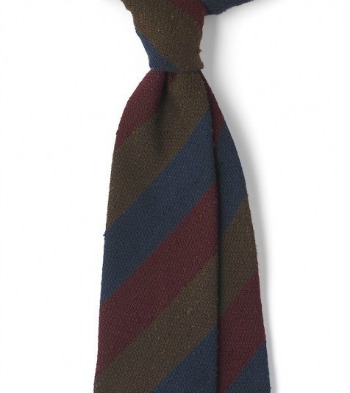With a box of unhemmed chinos staring at me for well over a month I finally broke down and decided to something about it. My dry cleaner takes at least two weeks to turn this around. My tailor takes one week, but he is an hour away. So that something turned out being learning how to hem them myself …with a cuff.
My first step was to learn how cuffs were constructed. I could have searched the internet for the perfect answer, but having a few pairs of chino with cuffs coming apart on their own I just looked at how they were constructed. That is all to say fair warning. There may be better methods out there.
Here is the formula that arrived at:
X” for cuff
+
X” for cuff
+
1” for hem
+
.5” to turn under
Amount of material required
I wanted 1.5″ cuffs.
My formula looked like this:
1.5” cuff
+
1.5” cuff
+
1” for hem
+
.5” to turn under
4.5” of material
 Next, I had to get the proper tools. Luckily my mom who has helped me out of more than one sartorial jam with her alteration skills agreed to help. She put together a simple sewing kit for around 10 dollars. This kit included everything (listed below) that I would need to hem my pants. She also volunteered her tutelage for the sewing portion of the project. A big thank you goes out to her for the help!
Next, I had to get the proper tools. Luckily my mom who has helped me out of more than one sartorial jam with her alteration skills agreed to help. She put together a simple sewing kit for around 10 dollars. This kit included everything (listed below) that I would need to hem my pants. She also volunteered her tutelage for the sewing portion of the project. A big thank you goes out to her for the help!
Tools required:
- Chalk
- Needles
- Thread
- Pins
- Seam ripper (I didn’t need this, because my chinos were unfinished.)
- Measuring tape for cloth
- Thimble
Creating the Cuff
- Mark chinos at desired length for wearing (if the pants are not unfinished like the ones I began with this is where I recommend letting the hem out.)
- Measure down X inches of material that is required for desired cuff size
- Double check measurement
- Cut off excess material
- Fold material up toward the outside by the amount of material that you added for the cuff (see bel0w)

- Iron material
- Fold the material down toward the bottom of the pants. The material will now pass the bottom of the pants by 1.5”.
- Iron material
- Turn the material inside of the pants by 1” and iron. You will now be able to see what the finished pants will look like.

- Pin the bottom of the cuff. I would put at least two pins in. One on each size.

- Turn the pants inside out

- Turn .5” of the extra material down behind this material
- Iron the material
- Take a break
Hemming the Cuff
- Thread the needle with 2-3 ft. of thread and tie a knot at one end of the thread
- Now we are going to start sewing. Take the needle and place it through the extra material pulling the know so that it will get stuck
- Next run the needle through a little bit of the main chino material. You don’t have to worry too much about the thread showing because we are sewing low enough that it the cuff will cover our marks. See the picture below to better understand the sewing method I described.

- Continue sewing like this until you get to the other seam
- We will now attach the top portion of the cuff to chinos so that they are secure
- Push the needle through to the outside of the pants
- Next going back and forth between the inside of the cuff and the main leg of trouser 4-6 times so that the thread is not visible
- After attaching the top portion of the cuff to the chinos push the needle back through into the inside of the chinos.
- Knot the thread and pull tight the thread tight so that you have enough thread to keep sewing
- Continue to sewing as you were in Step 3 until you come to the seam on the other side
- Repeat Step 7
- After completing Step 7 add 2-3 knots and then cut off excess thread
- Enjoy your freshly cuffed and hemmed chinos!
 Finished Product (Undisclosed Chinos)
Finished Product (Undisclosed Chinos)
Learning how to hem pants may be one of the most useful skills that I have learned. I feel liberated. No longer am I dependent on my tailor or the dry cleaner to hem a pair of trousers and the timeline to turn them around is now up to me. Plus, I save $20 for every pair that I hem myself. If you have any question about the process please don’t hesitate to ask. While creating this post I learned just how challenging it can be to write step-by-step directions.
















